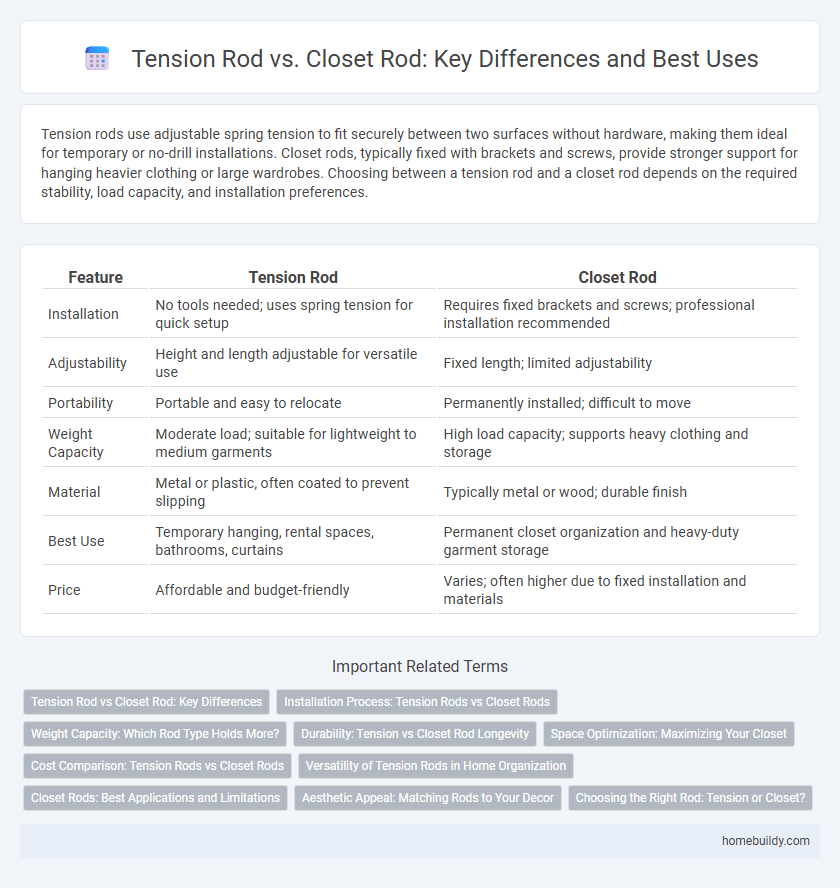Tension rods use adjustable spring tension to fit securely between two surfaces without hardware, making them ideal for temporary or no-drill installations. Closet rods, typically fixed with brackets and screws, provide stronger support for hanging heavier clothing or large wardrobes. Choosing between a tension rod and a closet rod depends on the required stability, load capacity, and installation preferences.
Table of Comparison
| Feature | Tension Rod | Closet Rod |
|---|---|---|
| Installation | No tools needed; uses spring tension for quick setup | Requires fixed brackets and screws; professional installation recommended |
| Adjustability | Height and length adjustable for versatile use | Fixed length; limited adjustability |
| Portability | Portable and easy to relocate | Permanently installed; difficult to move |
| Weight Capacity | Moderate load; suitable for lightweight to medium garments | High load capacity; supports heavy clothing and storage |
| Material | Metal or plastic, often coated to prevent slipping | Typically metal or wood; durable finish |
| Best Use | Temporary hanging, rental spaces, bathrooms, curtains | Permanent closet organization and heavy-duty garment storage |
| Price | Affordable and budget-friendly | Varies; often higher due to fixed installation and materials |
Tension Rod vs Closet Rod: Key Differences
Tension rods differ from closet rods primarily in installation and adjustability; tension rods use spring tension to fit between two surfaces without hardware, making them ideal for temporary or damage-free setups. Closet rods typically require mounting brackets and screws, providing a permanent and sturdy solution for hanging clothes in closets. The flexibility of tension rods suits lightweight uses, while closet rods support heavier loads and are designed for long-term use.
Installation Process: Tension Rods vs Closet Rods
Tension rods are installed without tools by expanding between two surfaces using adjustable spring tension, making the process quick and damage-free. Closet rods typically require brackets, screws, and tools for mounting, involving drilling and precise measurements for secure support. The tension rod installation is ideal for temporary setups, while closet rods offer a more permanent and stable solution.
Weight Capacity: Which Rod Type Holds More?
Tension rods typically support lighter loads, with weight capacities ranging from 10 to 30 pounds, making them suitable for curtains and lightweight garments. Closet rods, often made from sturdier materials like metal or thick wood, can hold significantly more weight, commonly supporting 50 to 100 pounds or more, ideal for heavy clothing and large wardrobes. Choosing between tension and closet rods depends on the required weight capacity and intended use in storage or decoration.
Durability: Tension vs Closet Rod Longevity
Tension rods typically offer greater durability due to their spring-loaded mechanism and sturdy metal construction, making them resistant to bending and sagging over time. Closet rods, often made from lighter materials like wood or thin metal, may warp or break under heavy loads, reducing their longevity. Choosing a tension rod ensures a longer-lasting solution for supporting weight in closets and other storage spaces.
Space Optimization: Maximizing Your Closet
A tension rod offers superior flexibility in space optimization compared to a traditional closet rod by enabling easy installation without tools or permanent fixtures, ideal for maximizing closet space. Unlike a fixed closet rod, a tension rod can be adjusted to fit various widths, allowing for customizable storage solutions that make the most of every inch. This adaptability supports strategic organization, helping to maximize vertical and horizontal space efficiently in closets of all sizes.
Cost Comparison: Tension Rods vs Closet Rods
Tension rods typically cost between $10 and $30, offering an affordable solution for temporary or lightweight applications. Closet rods, usually crafted from durable metals like steel or aluminum, range from $20 to $100 depending on thickness, length, and design quality. Choosing between tension rods and closet rods depends on balancing budget constraints with installation permanence and load-bearing needs.
Versatility of Tension Rods in Home Organization
Tension rods offer unmatched versatility in home organization by fitting seamlessly into various spaces without permanent installation, unlike traditional closet rods that require screws or brackets. Their adjustable length and easy repositioning make them ideal for hanging curtains, dividing spaces, or organizing closets and cabinets. This flexibility allows users to maximize storage efficiency while adapting quickly to changing organizational needs.
Closet Rods: Best Applications and Limitations
Closet rods excel in supporting hanging clothes due to their sturdy metal or wood construction, making them ideal for wardrobes with lighter to moderate loads. Their fixed length design suits standard closet dimensions but limits flexibility in custom or adjustable spaces. However, closet rods may struggle under excessive weight or in wide closets where additional support like tension rods can prevent sagging.
Aesthetic Appeal: Matching Rods to Your Decor
Tension rods offer a sleek, minimalistic look that seamlessly blends into modern decor, making them ideal for contemporary spaces seeking unobtrusive window treatments or closet organization. Closet rods, often bulkier and more visible, provide a traditional aesthetic suited for classic or rustic interiors where the hardware complements the overall design. Choosing tension rods allows for a cleaner, streamlined appearance, while closet rods can be selected in various finishes and styles to enhance the room's character and visual appeal.
Choosing the Right Rod: Tension or Closet?
Choosing the right rod depends on installation requirements and space constraints; tension rods offer easy, drill-free setup ideal for temporary or rental spaces, while closet rods provide sturdy, permanent support for heavier loads. Tension rods use adjustable spring mechanisms to stay in place between walls, whereas closet rods are typically fixed with brackets and screws for enhanced durability. Evaluate load capacity, installation permanence, and wall surface before selecting between tension and closet rods to ensure optimal performance and longevity.
Tension rod vs Closet rod Infographic

 homebuildy.com
homebuildy.com